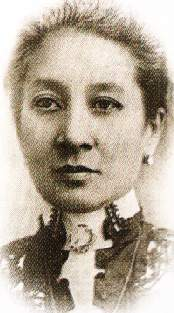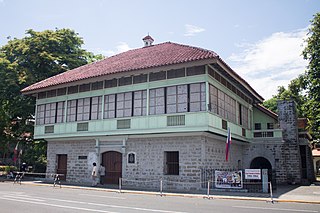
Batangas, officially the Province of Batangas, is a first class province of the Philippines located in the southwestern part of Luzon in the Calabarzon region. Its capital is the city of Batangas, and is bordered by the provinces of Cavite and Laguna to the north, and Quezon to the east. Across the Verde Island Passages to the south is the island of Mindoro and to the west lies the South China Sea. Poetically, Batangas is often referred to by its ancient name, Kumintáng.

Lipa, officially the City of Lipa, is a 1st class component city in the province of Batangas, Philippines. According to the 2020 census, it has a population of 372,931 people.

The Palacio de Torre Tagle is a building built during the colonial era of Peru that currently serves as the main headquarters of the Ministry of Foreign Affairs of Peru. It is located in the Jirón Ucayali in the historic center of Lima, two blocks southeast of the Plaza Mayor de Lima.

Tanauan, officially the City of Tanauan, is a 1st class component city in the province of Batangas, Philippines. According to the 2020 census, it has a population of 193,936 people.

Taal, officially the Municipality of Taal, is a 3rd class municipality in the province of Batangas, Philippines. According to the 2020 census, it has a population of 61,460 people.

Doña Marcela Mariño de Agoncillo was a Filipina who was the principal seamstress of the first and official flag of the Philippines, gaining her the title of "The Mother of the Philippine Flag."

Our Lady of Caysasay is a Roman Catholic image of the Blessed Virgin Mary venerated at the Archdiocesan Shrine of Our Lady of Caysasay in Taal, Batangas, Philippines. The image depicts the Immaculate Conception is believed to be one of the oldest in the country, originally discovered in 1603 by a native man fishing in the Pansipit River. The subsequent Marian apparitions documented by Spanish colonial church leaders were the first in the country; devotees today continue to attribute miracles to the Virgin.

The Casa de los Azulejos or Palacio de los Condes del Valle de Orizaba is an 18th-century Baroque palace in Mexico City, built by the Count of the Valle de Orizaba family. The building is distinguished by its facade, which is covered on three sides by blue and white colonial Talavera tiles from Puebla state. The palace remained in private hands until near the end of the 19th century. It changed hands several times before being bought by the Sanborns brothers who expanded their soda fountain/drugstore business into one of the best-recognized restaurant chains in Mexico. The house today serves as their flagship restaurant.

Sa Ngalan ng Ina is a 2011 Philippine television drama series broadcast by TV5. Directed by Mario O'Hara and Jon Red, it stars Nora Aunor and Christopher de Leon. It aired from October 3 to November 4, 2011, replacing Carlo J. Caparas' Bangis and was replaced by Glamorosa.

Ancestral houses of the Philippines or Heritage Houses are homes owned and preserved by the same family for several generations as part of the Filipino family culture. It corresponds to long tradition by Filipino people of giving reverence for ancestors and elders. Houses could be a simple house to a mansion. The most common ones are the "Bahay na Bato". Some houses of prominent families had become points of interest or museums in their community because of its cultural, architectural or historical significance. These houses that are deemed of significant importance to the Filipino culture are declared Heritage House by the National Historical Commission of the Philippines (NHCP), previously known as the National Historical Institute (NHI) of the Philippines. Preservation is of utmost importance as some ancestral houses have come into danger due to business people who buy old houses in the provinces, dismantle them then sell the parts as ancestral building materials for homeowners wishing to have the ancestral ambiance on their houses. These ancestral houses provide the current generation a look back of the country's colonial past through these old houses.

Doña Gliceria Legaspi Marella de Villavicencio, also known as Aling Eralian, is acknowledged as one of the famous Filipinos who gave her own wealth, time, knowledge and effort to help the Revolutionaries during the Philippine Revolution.
The following lists down historic houses in the municipality of Santa Rita, Pampanga, Philippines.

The Casa de Segunda, also known as Luz–Katigbak House, is a heritage house museum located along Rizal Street, Lipa City, Batangas. It was built during the 1860s and owned by Don Manuel Mitra de San Miguel-Luz and Doña Segunda Solis Katigbak, Dr. José Rizal's first love. The house was repaired in 1956 by Paz Luz-Dimayuga and was eventually declared a national heritage house by the National Historic Institute. At present, the house was converted into a museum.

The Villavicencio-Marella House or Wedding Gift House is an old Spanish Colonial Era house in Taal, Batangas, Philippines. The house was the wedding gift present of Don Eulalio Villavicencio to his wife Doña Gliceria Marella y Legaspi on the occasion of their wedding in 1871.

The Nakpil-Bautista House is a bahay na bato ancestral home found in the district of Quiapo, Manila, the Philippines. It was built in 1914 by Arcadio Arellano. The house originally sat on two lots, having a total area of 500 square metres (5,400 sq ft).

The báhay na bató, also known in Visayan languages as baláy na bató or balay nga bato, is a type of building originating during the Spanish colonial period of the Philippines. It is an updated version of the traditional bahay kubo of the Christianized lowlanders, known for its use of masonry in its construction, using stone and brick materials and later synthetic concrete, rather than just full organic materials of the former style. Its design has evolved throughout the ages, but still maintains the bahay kubo's architectural principle, which is adapted to the tropical climate, stormy season, and earthquake-prone environment of the whole archipelago of the Philippines, and fuses it with the influence of Spanish colonizers. It is one of the many architecture throughout the Spanish Empire known as Arquitectura mestiza. The style is a hybrid of Austronesian and Spanish architecture; and later, with early 20th-century American architecture, supporting the fact that the Philippines is a result of these cultures mixing. Its most common appearance features an elevated, overhanging wooden upper story standing on wooden posts in a rectangular arrangement as a foundation. The posts are placed behind Spanish-style solid stone blocks or bricks, giving the impression of a first floor. Still, the ground level contains storage rooms, cellars, shops, or other business-related functions. The second floor is the elevated residential apartment, as it is with the bahay kubo. The roof materials are either Spanish-style curving clay tiles or thatched with leaves, with later 19th-century designs featuring galvanization. Roof styles are traditionally high pitched and include the gable roof, hip roof, and a traditional combination of both. Horses for carriages are housed in stables called caballerizas.

The Quintana House is an example of the ancient architecture of the municipality of Guia de Gran Canaria in the Canarian island of Gran Canaria, located in the Plaza Mayor de Guía; its buildings date from the 16th century. The Canarian balcony is of Mudejar style, in wood and coat of arms with the surnames Guanarteme and Quintana.
Philippines National Historic Landmarks is a registry of historic sites in the Philippines that have been officially declared by the Philippine Registry of Cultural Property.

Martin Jesus Imperial Tadeo Tinio Jr., more popularly known as Sonny Tinio, was a Filipino antiquarian, art historian, interior designer, architect, author, and cultural worker. He was best known for chronicling the history of Philippine colonial architecture and Philippine antiquities in various publications in both the Philippines and overseas.

The Casa de las Campanas is one of the three oldest buildings in the city of Pontevedra in Spain, and perhaps the oldest civil building. It is located in Don Filiberto street, at number 11, in the old town.





















